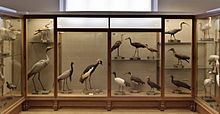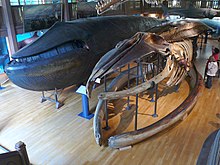Göteborgs Naturhistoriska Museum
Göteborgs Naturhistoriska Museum is the natural history museum of Gothenburg . It is located in Slottskogen above Linnéplatsen, named after Carl von Linné , in the southern part of the city.
history
The museum was founded on October 31, 1833 by the Royal Society of Science and Learning in Gothenburg . In 1923 the museum moved to its current premises.
There is space for changing special exhibitions in the entrance area, while the upper floors and the old building house the permanent exhibition. These are mainly animal models, with aquatic animals occupying a special position. The models are both dermoplastic , painted plaster casts and preparations preserved in liquid. Outstanding exhibits are the dermoplastics of a young blue whale stranded near Gothenburg in 1865 and that of an elephant killed in Angola in 1948.
Most of the exhibits in the permanent exhibition have not been renewed since the early 1970s. This leads in particular to the fact that more recent scientific findings, such as the reclassification of species , are not taken into account either in the composition or in the labeling of the exhibits.
Blue whale dermoplastic
The young, about 16.5 m long, male blue whale stranded in Askim Bay near Gothenburg on October 29, 1865 and was then bought and preserved by August Malm, the curator of the Natural History Museum. A week after it was found, the whale was publicly dismantled. After removing the fat, the pieces of skin were stretched and dried on wood. Water and fat were bound with salt and sawdust and turpentine , and the preservation was carried out by coating with an aqueous arsenic solution and later with mercury chloride and copal . This type of preservation turned the skin from dark brown to black, exactly as it can still be seen today.
The preserved pieces of skin were nailed with copper and zinc nails to a specially made wooden frame that was previously accessible and could be dismantled into four parts. The cut edges in the skin as well as the closely placed nails are still clearly visible on the model today. No attempt was made to obscure this and restore color to the model. In addition to the dermoplasty, there is the prepared skeleton of the whale (see picture).
The dermoplastic is the only one in the world for a blue whale. It used to be accessible and equipped with benches.
Elephant dermoplastic
The African elephant is an approx. 45 year old bull that was killed on December 4, 1948 in the Huila region of Angola . He had a length of 465 cm, a shoulder height of 332 cm and a tusk length of 240 cm. The total weight was 6 tons. The exhibit, prepared as a dermoplastic, was exhibited for the first time on March 29, 1952 and integrated into the permanent collection.
Spacewalk
On the outside is a model of the planets in our solar system on a scale of 1: 2,000,000,000 (1 in 2 billion ). The sun is shown as a yellow ball with a diameter of 70 cm in the outer wall, the planet Mercury , the closest to the sun, can be found on the southern slope of the hill on which the museum is built. Jupiter is to the west of the museum by the observatory , the dwarf planet Pluto is 3 km south of the disused mine of Högsbo. In the chosen scale, the earth has a diameter of 6 mm, the distance to the moon, not shown in the model, would be 190 mm.
literature
- Göteborgs Naturhistoriska Museum Årstryck, ISSN 0374-7921
- The Malm Whale, reprint of the museum from: Leviatan Från Göteborg. Grönberg & Magnusson, Glänta Production, 2002.
Web links
Coordinates: 57 ° 41 ′ 23.8 " N , 11 ° 56 ′ 57.8" E


